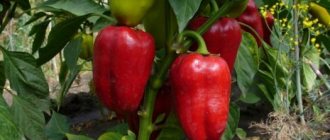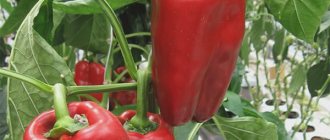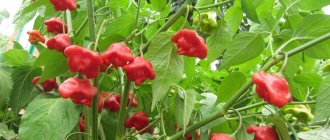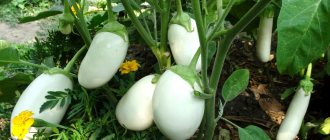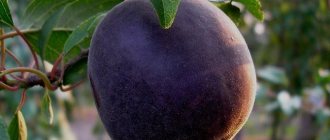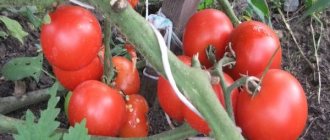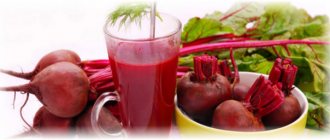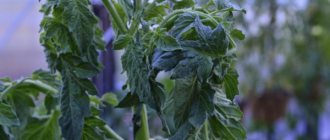Description of pepper Latino F1, reviews, photos
Early ripening, large-fruited hybrid of sweet pepper.
In the middle zone, it is recommended to grow it in a greenhouse. The period from germination to the beginning of ripening is 100-110 days. The bush is up to 1 meter high and requires tying to a support or trellis and shaping. The manufacturer recommends removing all side shoots and leaves up to the first fork and growing the plant in 2 stems.
Advantages of the hybrid : high marketability, heat resistance, resistance to tomato mosaic virus.
Fruit characteristics
The fruits are cube-shaped, in the stage of technical ripeness - dark green, in the biological stage - bright red, glossy, weighing 180–200 grams, juicy, excellent taste without bitterness. Wall thickness 8-10 mm. This pepper is great for fresh consumption, canning, home cooking, and making lecho.
Productivity : up to 14 kg of fruits per 1 sq. meters of planting (subject to watering and fertilizing).
Features of garden care
Seedlings are planted in cloudy weather or in the evening and protected from direct sunlight for the first few days. When growing in open ground or a greenhouse, it is necessary to weed, water a couple of times a week and feed twice a month with complete mineral fertilizer, alternating its application with watering with mullein infusion. If your pepper is growing in a greenhouse, you should provide it with a temperature of 20-25 degrees. In order not to have to run around opening and closing the greenhouse, especially if it is located far from your place of residence, it is convenient to install a hydraulic cylinder on a window or door. This unit will open the greenhouse when the set temperature is exceeded and close it otherwise. Its work is based on the property of bodies to expand when heated. When heated, the hydraulic cylinder pushes out the rod fixed on the window or door and opens it.
Peppers reach a height of about one meter and usually do not require staking in the same way as tomato bushes, since the trunk becomes woody. But if the plant is too covered with fruits, it is better to tie it up so that it does not break under their weight. Peppers are best picked at the stage of technical ripeness, when they have a dark green color. They will turn red beautifully if they are placed in boxes in a dark room, and during this time the grateful bush will set the next batch of fruits. When autumn frosts approach, several bushes can be transplanted into a pot, and they will bear fruit in your home all next winter.
Features of growing sweet peppers, planting and care
Sowing seeds for seedlings is carried out 65-70 days before the intended planting of plants in a permanent place. The optimal temperature for seed germination is 26-28°C. Shoots usually appear after 12-15 days.
When true leaves appear on the plants, they are transplanted into separate cups with a capacity of 0.3-0.5 liters.
Pepper does not like transplanting, so do not be surprised if after you have transplanted the seedlings into separate containers, they stop growing for a while. You can “smooth out” the stressful state a little by spraying the plants with Epin.
I’ve been into peppers for about three years now, the best seeds are always Semko, their peppers are the best. True, I always grew it in a greenhouse. Germination rate 9 out of 10 seeds, seeds are expensive but worth it. I tried their main red varieties, yellow and orange. Everything is great, but the red ones are bigger and juicier. They last a long time in the freezer and are very tasty when baked. Even in October, when you pick the last fruits, there are a lot of ovaries on the bushes. The harvest declared on the bags coincides with the greenhouse harvest. And they ripened outside for a long time, they don’t like the cold.
Latinos F1 is a sweet pepper created by Russian specialists. The variety appeared in the official register of breeding achievements of the Russian Federation in 2012. This vegetable is rapidly gaining popularity among farmers from various regions, as it has qualities desirable for gardeners and consumers. Below is a description of the main properties of the crop and the rules for its cultivation.
Collection and storage
Technical maturity occurs 85-90 days from sowing, when the fruits still retain their green color. You can leave the fruits to ripen directly on the plant, in which case ripening will be 100-110 days from sowing the seeds.
With a competent approach to sowing seedlings, the first fruits are harvested in June. When harvesting fruits of technical maturity, they are stored in deep boxes in two or three layers, lined with paper or sawdust. It would be ideal if each fruit is wrapped in paper.
Boxes with peppers for ripening are stored in a dark, cool (+9...+11 degrees) room (cellar, basement) with low humidity. After the onset of biological ripeness, the storage method changes.
Biologically mature (red) fruits are stored in perforated plastic bags that ensure gas exchange with the environment.
The shelf life of such fruits is no more than two months at low temperatures (from zero to two degrees) and at high humidity of about 90%.
Bell pepper Latino is universal in use, easy to grow and store. It retains its marketable appearance for a long time in a mature state and has high taste qualities. It has some requirements for cultivation, which are easy to meet even in regions not intended for growing the variety in open ground.
Read our other materials about such varieties of pepper as Ramiro, Aladdin, Claudio f1, Jalapeño, Carolina Reaper, allspice, Orange, Star of the East and Bogatyr, as well as about the nuances and subtleties of their cultivation.
Description of the variety
Pepper Latinos F1 is an early variety for greenhouses of all varieties. It has long stems - from 1.5 to 2 m. The branches are strong, with a lot of large dark green foliage. The direction of vegetables on the crop is drooping.
During ripening, the fruits differ little in color from other parts of the bush (with the exception of white buds). At the final stage of ripeness, the pepper becomes completely red. The photo clearly shows that the vegetable has the shape of a cube with rounded edges. The fruits have three-dimensional walls - 9 - 10 mm, significant weight - up to 250 g and width - 12 cm. Seed chambers - 3 - 4.
16 excellent varieties of plums for the Moscow region
Attention! Some gardeners confuse the hybrid Latinos F1 and pepper with the similar name Latino. However, according to farmers' reviews, these varieties have significant differences.
| Type of growth, bush height | Semi-standard, 90-100 cm |
| Ripe fruit color | Red |
| Planting scheme | 70x50 cm |
| Weight, length and shape of the fruit | 220 - 250 g, 12 cm, cuboid |
| Ripening period, yield | Early ripening (110 – 115 days), 9 – 14 kg/m2 |
| Drop off point | All types of greenhouses |
| Diseases | Resistant to the following viruses: bronzing, tobacco mosaic |
| By type of use | Universal |
| Flowering type | Mixed |
Description and characteristics of the variety
.eic-frame-35903 .eic-frame-35903 .eic-image
Sweet pepper Latinos F1 was bred by specialists. It was included in the State Register in 2012 and is recommended for cultivation in all types of greenhouses. In open ground, the vegetable takes root worse, but in the southern regions you can try growing it without a greenhouse.
The bush is indeterminate, tall, 1.5-2 m high. It is densely leafy, the leaves are dark green. In terms of timing, it is classified as mid-early, since the fruits reach technical ripeness on the 110-115th day after germination, although biological ripeness occurs late - after 125-135 days. The peppers are located on the bushes with their noses down, have a cuboid shape and are very large in size. Fruit weight – 220-250 g. The walls are very thick, 9-10 mm each. There are 3-4 seed chambers inside.
The pulp is juicy, tasty, aromatic. Used fresh, for preparing vegetable dishes, freezing and canning.
The hybrid has innate resistance to bronze and mosaic viruses.
Advantages and disadvantages
Latinos F1 pepper is valued for the following qualities:
- The culture has good resistance to dangerous viruses.
- The vegetable has massive pulp, which ensures juiciness.
- Pepper is harmonious in salads, first courses, hot appetizers, and retains its taste characteristics after defrosting.
- The hybrid has a significant yield - up to 14 kg/m2.
- The fruits have good transportability.
- Pepper does not die during prolonged hot weather.
Negative properties of the plant:
- the hybrid does not propagate by its own seeds;
- tall bushes require shaping and gartering;
- For this variety, planting in open ground is undesirable.
Recommendations for growing tall peppers in a greenhouse
If you want to grow indents indoors, you should take into account some nuances. Firstly, bell pepper is a warm and light-loving crop. Therefore, pepper beds need to be provided with an optimal temperature at which the plants will feel “at home.” Also, especially in the northern regions, it is important to provide the greenhouse with artificial lighting and turn on the lamps in cloudy weather.
Secondly, tall types of pepper are distinguished by unlimited growth of the bush, powerful stems, and strong foliage. During the growing season, numerous clusters bloom profusely and massively form dozens of fruits that pull the branches down. To prevent branches from breaking, care must be taken to install reliable supports and properly tie up the main trunk of the plant and overloaded parts.
Thirdly, even being in seemingly ideal conditions, bell peppers will ripen according to the stated ripening dates. No amount of fertilizing or other manipulations will make, for example, a mid-late variety into an early variety. All that can be done is to protect the pepper bushes from all sorts of unfavorable factors and wait for a harvest that will be tasty and stable.
Features of tall plant agricultural technology
Peppers must be grown using the seedling method. The effectiveness of a gardener’s work when planting a crop is determined by compliance with several basic requirements:
- seeds are germinated at a temperature of 23 - 25 degrees;
- seedlings are moved to the garden bed after reaching the age of 50 - 60 days;
- up to 3 crops are planted per 1 m2;
- pepper is watered using the drip method;
- the first feeding is carried out 10 days after planting in the greenhouse;
- bushes are tied to trellises;
- on plants, all branches are removed up to the main fork, then 2–3 trunks are formed.
Sowing seeds for seedlings
Planting seedlings in a greenhouse/greenhouse
Planting seedlings in exhaust gas
Stepsoning
Harvesting
Reviews
Pepper is known to a large number of experienced farmers and ordinary summer residents. The following reviews are left about it:
- The fruits have impressive walls and are delicious - from Natalia from Bryansk.
- The seeds have excellent germination, the pepper is productive, and resistant to viruses - from Tatyana from Moscow.
- This variety is more productive than Latino - from a gardener under the pseudonym “Charlie”.
- Familiar summer residents recommended the vegetable as a crop with good yield - from a gardener from Lipetsk.
Pepper Latinos F1 belongs to the thick-walled productive varieties. It is able to resist dangerous diseases. However, the inconvenience for farmers is the need to tie up and shape the plants.
Flower bed design. TOP 10 simple and effective techniques
Criteria for the Kupets variety
Whatever the characteristics of the variety, it will suit gardeners in all respects. There are types of culture that have no disadvantages and are suitable for everyone. The merchant belongs to this category.
- Standard.
- Height 85 cm.
- Ripening period: 110-115 days.
- Shape: pyramidal.
- Weight: 100 g.
- Wall thickness: 8 mm.
- Number of sockets: 2-3 pcs.
- Color: red.
- Pulp: aromatic and juicy.
The final choice always remains with the vegetable grower, who chooses the most suitable variety for the needs of the family.
Red pepper varieties with smaller fruits
Red pepper varieties with fruits ranging from 100g to 180g are considered medium-fruited, and they can also be thick-walled.
The Best Medium Fruit Red Peppers
: Good Man, Fat Baron, Player, Kolobok, California Miracle, Hercules, Claudio F1, Isabella F1, Magician, Chord, Bogatyr.
Player
The pepper variety Player was created by agro specialists.
The variety underwent variety testing in 2003 for registration in the register of selection achievements. And already in 2004, pepper was included in the state register. The variety was allowed to be grown throughout the Russian Federation in private household plots and small farms. Moreover, it can be cultivated both indoors and outdoors. Description of the variety
:
Red pepper varieties such as Player are early ripening. The variety is able to ripen within 100 - 105 days after all the seeds have hatched.
The plants have low-growing, semi-spreading bushes that grow up to 50 cm in height. The foliage is medium with small, slightly wrinkled leaves of a dark green color.
The peppers are cube-shaped with slightly pronounced ribbing. At the initial stage, the color of the fruit is yellowish, and when fully ripe it is dark red. Drooping. Weight 110 g - 130 g. Wall thickness 7 mm - 10 mm. When cut, you can see 3 or 4 seed chambers.
Advantages of the variety
:
- Large and thick-walled fruits.
- Early ripening (100 - 105 days).
- Excellent presentation, which is not spoiled even by long-term transportation.
- Excellent resistance to major diseases.
- Good yield indicators (5 kg - 6 kg per 1 sq. m). Due to the compactness of the bushes, the frequency of planting can be increased, and this will result in higher yields.
- Universal application.
- Friendly maturation.
Disadvantages of the variety
:
- Requires regular watering.
- Attacks by harmful insects are possible, so preventive measures are important.
Claudio F1
The pepper hybrid Claudio F1 was developed and bred by Dutch breeders from agriculture in 2005.
And after variety testing in 2007, it was successfully registered in the Russian state register of breeding achievements. The hybrid was approved for cultivation only in one North Caucasus region, and only in open ground. But this is official on paper, but in fact the hybrid is successfully grown in greenhouse conditions, as well as in other regions. Hybrid characteristics
:
Red pepper varieties such as Claudio F1 ripen early. The hybrid has a growing season of 95 - 115 days after full germination. Important
: The speed of ripening directly depends on the growing conditions and region.
The culture has a semi-spreading bush growing up to 70 cm in height. The leaves can be medium to large in size. And the color is from green to dark green.
The fruits are drooping and shaped like a prism. The average weight is 100 g - 172 g. Their color is green at the initial stage, and red when fully ripe. The thickness of the walls is 7 mm or 8 mm. The pepper contains 3 or 4 seed chambers.
Pros of a hybrid
:
- The hybrid is distinguished by large fruits, although some varieties and hybrids may have larger fruits (see above).
- Stress resistance. The hybrid easily tolerates temperature changes and other natural disasters.
- Transportability. Peppers travel well.
- Decent immunity from diseases.
- Sweet and without bitter taste with a strong aroma.
- The purpose is universal.
- High yield (8 kg - 10 kg per 1 sq. m for greenhouses, and in open beds 4 kg - 5 kg).
Cons of a hybrid
:
- The crop requires proper care, and this is the only way to get a decent harvest.
Isabella F1
The pepper hybrid Isabella F1 was created by breeders from VNIISSOK in 2002.
Then there were variety trials, and then in 2003 the hybrid was included in the state register of breeding achievements. It was allowed to be grown in such regions as Central, Volga-Vyatka, Central Black Sea Region, North Caucasus, Middle Volga, Northern, Northwestern. Description of the hybrid
:
Varieties of red pepper, such as Isabella F1, ripen within 120 - 125 days after the seeds hatch.
The plant is a closed standard type, growing up to 60 cm in height. Its leaves are large and slightly wrinkled, which are colored green.
The fruits have a prism-shaped shape. They are smooth to the touch. In technical ripeness, the fruits are yellowish in color, and in biological ripeness they are red. Weight 100 g - 120 g. Wall thickness 7 mm - 9 mm. There are 3 or 4 seed nests. Grow downwards (drooping).
Hybrid values
:
- The fruits are medium in size, which can be large.
- Harvest from 1 sq. m area is removed up to 10 kg.
- Universal application. The hybrid can be eaten fresh in salads, made into winter preparations and various dishes.
- The taste and product quality are excellent. Pepper has a rich sweet taste.
- The hybrid is distinguished from others by better keeping quality and transportability.
- Easy to care for crops.
Disadvantages of a hybrid
:
- Impossibility of obtaining seeds of own production.
Good guy
The Dobryak pepper variety was created by Kirov (Kirov) agricultural specialists in 2000.
And then in the same year the variety was submitted for an application for variety testing. And already in 2001, the Dobryak variety was registered in the Russian State Register. Pepper was allowed to be cultivated in all regions of the Russian Federation in closed ground on small farms and in private household plots. Characteristics of the variety
:
Red pepper varieties such as Dobryak are considered early ripening. The variety has a growing season within 95 - 100 days after germination.
The culture has a semi-spreading standard-type bush with slightly wrinkled green leaves. Under favorable conditions, the plant can grow up to 1.5 m in height. This means that it must be shaped and tied up.
The peppers are round and smooth. And at the beginning they have a light green color, and then turn red. Moreover, their weight can be 100 g - 110 g. The number of nests is 2 or 3 pieces. The walls have a thickness of 9 mm - 10 mm.
Advantages of the variety
:
- Early ripeness (up to 100 days).
- Decent yield (8 kg - 10 kg per 1 sq. m of plot).
- Excellent presentation, which does not deteriorate due to transportation.
- Not badly stored.
- Stress resistance. Easily adapts to bad weather conditions, as well as to new regions.
- Characterized by long-term fruiting.
- It is resistant to major diseases.
- They are used for fresh consumption, as well as for preservation.
Disadvantages of the variety
:
- The need to form and tie up bushes.
Bogatyr
The pepper variety Bogatyr was bred at the Transnistrian Research Institute of Agriculture.
The application for variety testing was submitted in 1993. And only in 1996 the variety was included in the state register of the Russian Federation. The crop was allowed to be grown only in two regions of the Russian Federation such as the North Caucasus and Lower Volga. Suitable for industrial purposes in the canning industry, as well as for fresh consumption. Description of the variety
:
Red pepper varieties such as Bogatyr are medium late. The variety has a ripening period of 115 - 130 days after all the seeds have been pecked.
The plant is spreading and of medium height (55 cm - 70 cm) with dark green large leaves.
The peppers are cone-shaped. The fruits are hanging with slightly pronounced ribbing. When technically ripe, peppers have a light green color, but when biologically ripe, they are red. The average weight is 75 g - 100 g. The wall thickness of the culture is 5 mm - 6 mm. The sugar content in fruits is 3.1% - 6.7%.
Advantages of the variety
:
- The variety can adequately survive temperature fluctuations.
- Product quality is excellent. And they are not lost even during transportation.
- High yield (up to 7 kg per 1 sq. m).
- Good immunity.
- Sweet taste with rich aroma. Sugar in fruits contains up to 6.7%.
- The hero easily tolerates a lack of light.
Disadvantages of the variety
:
- The variety is susceptible to aphid attacks.
- It is advisable to shape and tie the bushes because they are fragile.
Pepper cultivation
Peppers require a lot of attention and care. It is grown mainly by seedlings. Seeds are sown at different periods, the period depends on the day of planting in a permanent place. They begin to sow at the end of February and finish at the beginning of May.
The roots of plants are very delicate; with a slight injury, the entire plant can wither. Therefore, summer residents grow them in separate containers, or peat pots. The latter, in turn, when transplanted into the ground, are an excellent root fertilizer.
After sowing, it is recommended to cover the containers with polyethylene or glass. After sprouting, open immediately.
When 2 true leaves appear, the sprouts are pinched, removing the growth point that is located above them. This helps the peppers form side shoots and stop growing upwards.
When transplanting to a permanent place, it is recommended to place 4 plants per 1m2. 10 days before, begin hardening off the peppers, preparing them for the harsh outdoor growing conditions.
Caring for the variety
One of the main advantages of Kupets pepper is its unpretentiousness. Therefore, you won’t have to take special care of it:
- Soil moisture should be monitored; plants should not dry out or be flooded with water uncontrollably.
- Remove weeds and periodically loosen the soil. Access to oxygen to the roots is necessary for proper growth.
- Feeding. There is no need to be zealous in this regard. Plants need to be fertilized after transplantation and during fruit appearance. Feeding before the formation of ovaries will lead to the formation of green mass, there will be no flowers or fruits.
- If the pepper blooms within 10 days after transplantation, you need to remove the inflorescences. The plants have not yet taken root, they will become sick and produce a weak harvest.
What do you need to get rid of slugs and snails?
We should simply take a head of garlic, mash it and then make an infusion. We make the infusion in about a liter of water. Then we take 100-150 grams of solution. After three days of infusion, we dilute up to 10 liters of water and spray our plants from all sides. This is completely harmless for plants, but slugs will not come to us and will not eat our fruits.
As a rule, when biological ripeness occurs, they settle here, even overwinter in this depression and continue eating, even climbing inside the pepper. Therefore, the easiest way is garlic. You can use this solution, which you make from one head of garlic, for a long time.
Now, as always, we must weigh this fruit. We weigh the fruit. In general, practically at technical ripeness, it already weighs 146 grams. But, it is clear that when it fills and ripens even more, it will reach 200 grams and the flesh will thicken.
Now we’ll check how thick the flesh of the Latino pepper is. Let's cut it crosswise, as always, and make sure. Good pepper. You can see that the pulp has not yet reached its final thickness. About 7 mm in thickness. I'm sure it will add another 2 millimeters.
I hope that you also really, really liked this pepper. The yield is very good, about 10 kg on average per square meter, that is, from 3 plants. So plant this pepper and enjoy its taste.
And now, as always, we will try again. Juicy, sickly sweet. It is still ripe, in general it is still in technical ripeness; the pepper has not yet acquired its full color, it has not yet fully matured. I think you will also like it very much, and you will grow this wonderful hybrid on your plots.
Application and yield volume
The versatility of the fruits of the Kupets pepper is reflected in numerous reviews from summer residents. The vegetable is suitable for canning, freezing, and eating fresh.
The yield of the variety, according to the manufacturer, is 3 kg per 1 m 2. But with proper care and all the requirements of agricultural technology, 5.5 kg per 1 m 2 is collected.
Pros and cons of Kupets pepper
The presence of advantages in the description allows the variety to quickly gain popularity. Positive properties:
- Stable harvest.
- Unpretentiousness.
- Frost resistance.
- Ability to set fruit under unfavorable weather conditions and temperature changes.
- Versatility of use.
- High commercial quality of fruits.
No disadvantages identified.
Opinions of summer residents regarding the Kupets pepper variety
Positive reviews from gardeners work better than any advertising. A novice vegetable grower receives a lot of useful information and specific recommendations.
Nikolay: “I grow “merchant” peppers every year. Externally beautiful fruits do not require care. But the main advantage is in the taste. It is possible to collect the seeds yourself. But it’s better to periodically update the variety, as over the years it loses its characteristics.”
Natalya: “I got acquainted with the variety at the seedling stage. Since I am new to gardening. Unpretentious, grew up in the country, looked after once a week, it was not possible to come more often. The beds were mulched to retain moisture. Next year I will grow it myself, using seedlings.”
Latino variety criteria
Another variety of tall pepper. The summer resident will fully appreciate its advantages only after he grows it on his plot.
- Height: 1 m.
- Ripening period: 100-110 days
- Shape: cuboid.
- Color: red.
- Wall thickness: 8-10 mm.
- Fruit weight: 180-200 g.
- Taste: rich and aromatic.
- Can be stored for a long time.
Thus, Latino pepper meets many characteristics. Especially for those summer residents who cannot devote much time to caring for their crops.
Advantages of pepper
The vegetable grower evaluates the advantages, according to reviews from those who grew it on their plots. Often a large number of disadvantages leads to the fact that a variety becomes unpopular.
- Productivity.
- Great taste.
- Unpretentiousness.
- Versatility of use.
- Resistance to TMV.
- Independence from weather changes.
- Hybrid seeds do not retain maternal genes.
Some positive properties will seem to the gardener, on the contrary, as disadvantages of the variety, so everyone evaluates from their own experience and preferences.
The opinion of summer residents regarding the hybrid Ekaterina
The decisive criterion in making a decision as a vegetable grower is the presence of a large number of positive reviews.
Yuri: “It was a bad spring, a cold summer, but the pepper still produced an excellent harvest. I liked the large, fleshy, large fruits of the hybrid.”
Tatyana: “Very good pepper. Productivity is beyond praise. The only negative is that it is not suitable for stuffing, but the entire harvest was used for making salads. I will definitely grow more.”
Pepper lovers will be pleasantly surprised by the unpretentiousness of these tall varieties of the crop.
Features of cultivation
Latino is no different from other hybrids in planting and care. The main agricultural techniques are watering, fertilizing, and loosening. 4 plants are planted per 1 m2.
Formed into 2 stems and tied to supports.
Hybrid immunity. Use of vegetables. Productivity.
Latino peppers are resistant to tobacco mosaic virus. Preventative treatments are required against insect pests and other diseases.
Vegetables are universal in use, eaten fresh, canned and frozen.
14 kg of pepper is collected from 1m2.
Criteria for the variety Ekaterina
After reading the description of the variety, gardeners know exactly whether the species is suitable for the needs of a particular family or not.
- Indeterminate.
- Height: 70-80 cm.
- There are 18-20 peppers on one bush.
- Ripens within 110-112 days.
- Shape: cylindrical.
- Color: red.
- Weight: 110-170 g.
- Length: 15 cm.
- Diameter: 6.5-7.5 cm.
- Wall thickness: 6-7 mm.
- It is stored for a long time, maintaining its presentation.
The tall variety of pepper Ekaterina is universal in use and resistant to disease, so those summer residents who grew it will not exchange it for any other.
Varieties for growing in greenhouses and greenhouses
Sweet pepper is one of the most heat-loving crops, so it is often necessary to plant seedlings in a greenhouse or greenhouse made of film. In closed ground, plants suffer less from temperature changes, and in the event of a cold snap, it is easier to protect them from low temperatures by organizing heating.
It doesn't have to be an electric heater. Resourceful gardeners use homemade stoves - buckets of heated bricks. Hot water bottles. If you plant a variety intended for a greenhouse outside, the bushes may develop worse, they may drop flowers and ovaries, which will lead to a decrease in yield. That is why it is better to follow the manufacturer’s recommendations regarding the growing method.
"Heavyweight"
A large-fruited variety that produces square-shaped fruits, the weight of which exceeds 200 g. At the stage of full maturity, the peppers become golden-orange. The wall thickness is about 1 cm. The pulp of the vegetable is fleshy and aromatic. “Heavyweight” can be grown in any region of Russia. The variety has strong immunity. Productivity in the greenhouse is up to 8.5 kg per 1 sq. m.
As it grows, the bush becomes spreading and tall. The manufacturer recommends growing the variety under film cover and in greenhouses. “Heavyweight” was added to the state register relatively recently, but is already loved by summer residents for its large fruit size, excellent taste, versatility and unpretentiousness.
"Star of the East red F1"
Popular hybrid from agro. Pepper is suitable for growing in any climate and is disease resistant. The variety is planted in greenhouses; in the south, “Star of the East” can be grown in open ground. Maximum yield – 7 kg per 1 sq. m. Fruits at the stage of full maturity acquire a dark red color. The average weight of peppers is 150 g. The wall thickness is 8-9 mm.
Standard tomatoes: 8 varieties that will delight you with the taste and abundance of the harvest
The hybrid has a good taste. The fruits are widely used in cooking. The height of the bush in open ground is 60 cm; in a greenhouse, plants grow up to 90 cm. The variety belongs to the mid-early varieties. The rate of fruit ripening depends on growing conditions. The peppers are cuboid in shape. The pulp is juicy and contains a large amount of sugars. The aroma is weak.
"Latinos F1"
A productive hybrid, under any conditions giving a yield of up to 12 kg per 1 sq. m. Wall thickness - up to 1 cm. High productivity is achieved due to the large dimensions of the bush. Gardeners value “Latinos” for its large fruit. The peppers are cube-shaped and weigh more than 250 g each. The hybrid is resistant to heat, bad weather, and typical diseases.
“Latinos” is part of the group of early ripening varieties; it is grown in film greenhouses and greenhouses. When ripe, the fruits acquire a scarlet color. Pepper is added to salads, first and second courses are prepared from it, and preparations are made. The height of the bushes reaches 1 m, so the plants require a garter.


